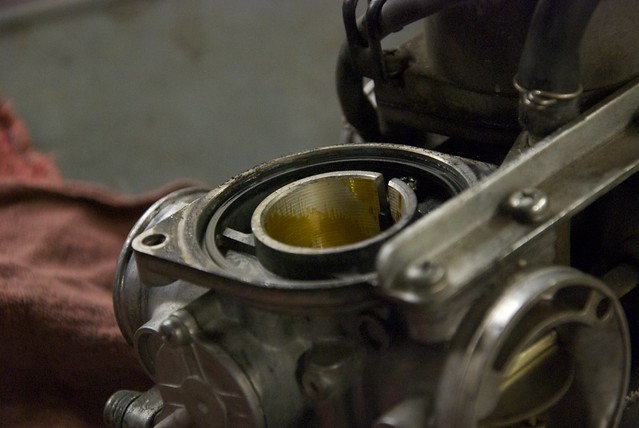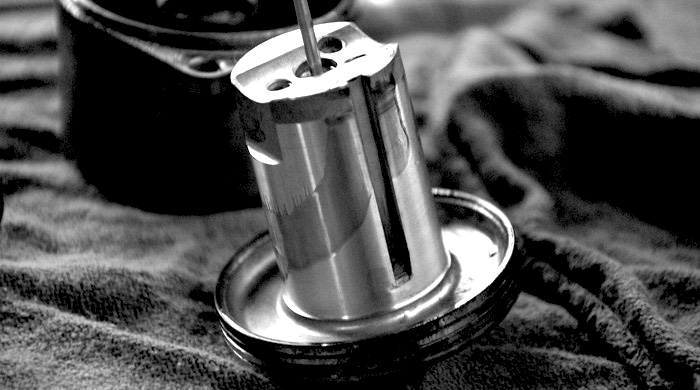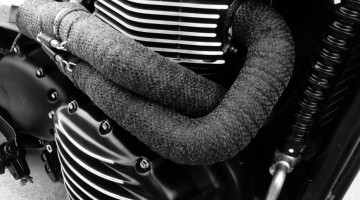If I’ve learned anything from working on motorcycles, it’s that only fools make plans. That is, at least where scheduling is concerned. Having a plan of what you’re doing and when you’d like to get it accomplished is good project management. However, what I’ve learned over and over is that making specific, scheduled plans for a motorcycle that doesn’t run is usually a recipe for disappointment. I wanted the GL1100 to be ready in April, then I got laid off. I wanted the CB450 to be running by my birthday in June, but the carb kits took a month to come in. Things usually work out, but to the casual motorcycle mechanic, the machine is going to dictate the schedule,
I learned this lesson for the ump-teenth time after acquiring a half barn-rotten CB750 from a buddy of mine. It’s a great machine, but this meant I was up to three bikes this season, none of which were roadworthy. It was downright laughable. This was not the plan when the season started. I was supposed to have two good bikes of my own by that point, and this bike would be a custom project. My plans had been thwarted. The CB450 was still on the engine transplant list. The GL1100 was waiting on a dozen little parts. Each time I thought I was close to having a running bike, something mechanical or logistical would get in my way. As the season pushed on into Autumn, I got a bit discouraged. Winter would be here in a blink if I didn’t get busy. If I wanted something of my own to ride, I’d have to abandon my original plans for the season and improvise. See, I’m learning right?
So with my other two machines languishing, I turned my attention to the CB750 in early September. I’d bought it back in June from my friend Justin, who I’d worked with during my year+ in the wacky world of product development. This machine was, conceivably, just a carb clean and a brake job away from road worthiness. If the machine would cooperate, I might be able to salvage the tail end of riding season. I didn’t make any specific plans, but I was definitely in a hurry. I wanted something I could ride as soon as possible.
This particular bike is the 1981 model of Honda’s iconic CB750, and was one of the last proper CBs Honda produced before adopting the Nighthawk moniker and corresponding ugly bodywork. The model started in 1969 as the genesis of what we know today as the superbike. With the world’s first production inline four-cylinder engine, the CB750 revolutionized the motorcycle scene that’d previously been dominated by parallel twins from England such as the Triumph Bonneville. Truth be told, I appreciate the history behind the CB750, but I never really wanted one. Even though I’m a big guy, I still prefer smaller, midsize bikes. The CB750 weighs in at a hefty 560 lbs, but is propelled along by 77 howling horsepower. It’s only slightly smaller than my GL1100, actually. It’s a bit top heavy, if we’re honest, and like all older inline four cylinder engines it’s far too fussy setting off in first gear. This due to a complete lack of torque in the lower revs. So why bother then? The appeal of this particular CB750 was in its resurrection. I wanted the experience of bringing a bike back to life.
When a motorcycle sits for even a few months, let alone years, its systems will atrophy. Rubber parts harden, metal pieces oxidize and corrode, and worst of all, gasoline turns into a sticky, golden slime. This effects the carbs most profoundly. While often intimidating, motorcycle carburetors are really just one part toilet, one part swiss watch. They’re precise, but ultimately simple. The sticky slime of old gasoline literally gums up the works, but a careful cleaning can quickly set them right again. Therein lay the appeal of this particular motorcycle. At just under 30,000 miles, this old Honda has plenty of great life left in it, but isn’t worth a whole lot in mothballs. Thankfully, engine internals tend to hibernate well, so if you’re willing to do the work, you can bring the bike back to life and more than double its value. I even had thoughts of a Wrenchmonkees-style custom project, as this bike seemed the perfect, inexpensive candidate. Before any of that could happen though, there was work to be done.
When I took delivery of the bike in June, the front brakes were frozen, the petcock was gummed up with tank liner and I was sure there was sludge in the carbs. The bike had a lot going for it though. It already had low, superbike-style handlebars on it. It had a comfortable, if unattractive stock Honda seat. The CB750 also had a decent coat of dark green paint on the tank and side covers. It’s not a stock color, but it doesn’t look like a shitty “rattle can” job either. It was definitely a bike with “good bones” as they say. It’d sat a long time, but at least it hadn’t been left out in the elements all those years.
I made an appointment with Jeff down at BlueCat to get some lift time in early September. Having recently endured 13 hours of carb rebuilding woes with the GL, I was looking forward to the straight rack of carbs on the CB750. In theory they’d be a lot easier to get on/off the bike and a bit simpler to rebuild. As with most bikes, first the seat had to come off. Two bolts away and that was done. Next came the tank, which is just a single bolt in the rear and a matter of disconnecting the fuel line from the petcock. This procedure gave me my first sense of the state of the rubber on this machine. The fuel lines were pretty hard, brittle and positively fused to their fittings. There was no getting them off with any hope of reusing them. That’s not really an issue, as fresh lines are easy enough to install, but it certainly stalled my progress and made the rest of the bike’s rubber bits suspect.
A successful tank extraction finally exposed the rack of carbs between the engine and the intake box. I began loosening all the hose clamps that attach the boots on both sides of the rack, inspecting the boots as I went. Sometimes, due to both age and engine heat, these boots can dry out, get hard and no amount of clamp pressure can get them to seal correctly. This leads to air leaks, which leads to lean running, which among other issues makes the bike run like crap. The boots on the CB750 still seemed pretty soft and pliable. Chances are they’re the second set the bike has seen. That’s a good thing. They’d been on there a long time though, so what they lacked in rot they made up for in inertia. It took me, Jeff and a crowbar to finally get the engine side boots to turn loose of the rack. By loosening the air box mounting bolts, I was able to make just enough room to finally slide the rack out the right side of the engine. That is, once I disconnected both throttle cables and
(Ranting sidebar) I don’t understand why throttle and choke cables connect the way they do on most motorcycles. They’re a common fail item and a critical hurdle in servicing the carbs. Yet, getting them connected and disconnected is often the most difficult part of servicing the carbs. You basically have to take half the bike apart to even get to them. The gods help you should you need to replace a throttle pull cable on the side of the road! Because the hookup tends to be in the center of the carb rack, even on a twin like my wife’s CM400 you almost have to pull the carbs off before you can really reach the connections with tools. The more carbs you have, the harder they are to reach. It’s maddening! Why the hell don’t these simply connect on one end of the rack? Not only would they be easier to service, but you could even visually inspect them before each ride! Stupid. Throttle cables are my least favorite wrenching task to date. Hate them. (End ranting sidebar)
With the rack finally in hand, it was time to assess the extent of this bike’s atrophy. Not only had it sat for about five years, it hadn’t been properly put away. I knew there was old gas in the bowls, but only cracking them open would reveal just how much gunk had been
It was a lot of gunk.

Starting on the first carb in the rack, I pulled the top, removed the spring and extracted the vacuum piston. It resisted me pretty strongly as I pulled it out of the carburetor body because a thick layer of metallic slime coated the piston’s outer surfaces. It was thick and bright gold — like honey from robot bees. It was gasoline left over from the Bush administration, and in character, it’d left a mess. Working my way down the rack, each piston was coated in the same sticky slime, just as I’d expected. Flipping the rack over, I pulled the bowls and found more of the same. More Terminator honey. If the bowls and pistons were this thick with the stuff, then it guaranteed each of the carb’s fuel and air circuits would be just as plaque-ridden. Fuel this old is like cardiovascular disease in a motorcycle. It clogs all its vital passage ways and keeps speed-giving fuel from reaching the beating heart of the engine. Without careful attention, this patient would remain dead on
An hour of cleaning in the ultrasonic dunk tank, plus copious amounts of pressurized carb cleaner soon had the CB750’s major arteries clear again. I cut down a new accelerator pump as Jeff used compressed air to blow the last remnants of gunk and cleaner out of the carbs. The bottom bowl of the accelerator pump was especially gummed up, so we had to toss it into the caustic bath to get it squirting properly. What’s an accelerator pump? Basically, it’s a plunger. Remember what I said earlier about a carburetor being a toilet? Well it comes complete with a plunger. There’s a small paddle on the throttle assembly that pushes down on the “handle” of the plunger, if you will. The plunger pushes a small volume of fuel, under pressure, through separate fuel passages in each carburetor, to a little squirting head in the throat of each carb. Every time you crack the throttle open from idle, you get a little squirt of fuel in each carb. What this does is offset the EPA-mandated “lean burn” mixture these carburetors were required to adopt in the late ’70s. The accelerator pump lets you to have that lean idle mixture, but helps offset it when you first get on the throttle. That little extra shot of fuel when you crack the throttle helps bridge the gap between the idle circuit and the mid-range circuit. Otherwise the engine would bog every time you came off idle because it’s fuel starved. The result is better acceleration, hence the name.
With the carbs rebuilt, I set about fitting new fuel lines to the vacuum fuel cutoff and bench tested the rack on a “baby bottle” — a half gallon bottle of fuel that you hang from the bench like an IV. The point of the bench test is two-fold. Make sure nothing leaks, and make sure the accelerator pump is squirting properly in each carb. This is especially critical in these four carb racks because there are numerous passages that might still be clogged and numerous o-rings that may have rotted out. You want to make sure the accelerator pump is working and make sure there aren’t any leaks or overflows. Better to find these things on the bench then after you’ve gone through the half hour ordeal of reinstalling the rack in the motorcycle.
Thankfully, my rack wasn’t leaking and with a bit of adjustment, the accelerator pump was squirting happily. At least, it was squirting happily in two of my four carbs. It’s here I must make a confession. In my haste to have something — anything to ride — I assumed that the those passages would simply clear with time. It was late. I’d been at BlueCat for hours at that point and wanted to get out of their hair. So I cut a corner, hoping for the best once the carbs were installed, level and had fresh fuel running through them under pressure. Time would tell if I’d gotten away with my lazy haste, or if I’d have to pay the piper and pull the rack again. In the mean time, I took the risk and rushed on. In retrospect, even though I got away with it, I wish I’d done it right the first time. If assumption is the mother of all fuck ups, impatience may be the father. It’s one of many important lessons my recreational wrenching is teaching me.
Despite my desperation to finish, at the time I felt like I was cruisin’. I was getting excited that I’d soon have a bike of my very own that I could ride. At my next repair session, I’d reinstall the carbs and see how well I’d done — see if I’d avoided disaster. Little did I know, I was much further from being loud and fast than I thought, but it was the unexpected, as always, that would slow my progress.
Only fools make plans, remember?
To be continued…
![]()




